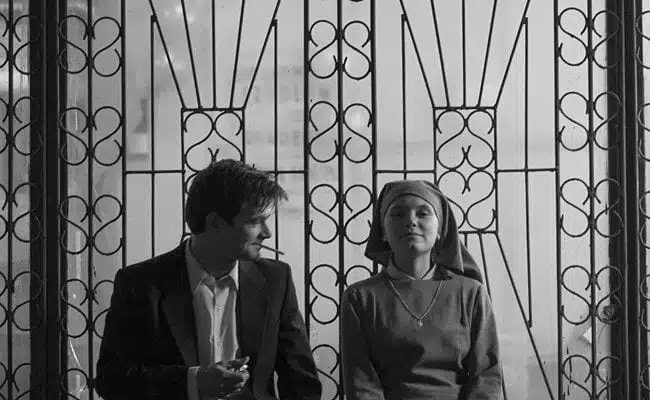
As I try to discover the opening of this review, I find myself lost in uncertainty, questioning if I have imagined reading a quotation from John Huston about his willing compromise to make a film for money followed by a film for art. Despite having searched for the quotation, it has so far evaded me, which means that this opening could be based entirely on a fictitious memory.
Do these words suggest that Huston was a filmmaker who frequently sought redemption, and does that brand art as a potentially redemptive act? Pawel Pawlikowski’s Ida is one film that could be described as an act of redemption. However, the word “redemption” may be an inappropriate adjective, as it is suggestive of a filmmaker who has achieved a higher stature than is reasonable to assert Pawlikowski as having attained. So in retracting this phrasing, perhaps it is more fitting to describe Ida as less an act of redemption and more a sign of promise for what the future may hold.
From 2004 to 2014, Pawlikowski offered us three films for our cinematic pleasure: My Summer of Love, The Woman in the Fifth, and now Ida. Whilst the first of the three offered a semi-interesting tale of the familial, religion, and confrontation with one’s own identity, it was dispatched into the shadows by his 2011 foray in Paris, The Woman in Fifth, starring Ethan Hawke as an American writer. Ida may now represent the line that separates Pawlikowski’s murky past from his potentially bright future.
The opening image of the preparation of the statue of Christ for display in the snow-covered convent grounds is one that resonates throughout Pawlikowski’s film. It is symbolic of the way in which our time will be spent with Ida (Agata Trzebuchowska) as she prepares herself for a life in the service of God. Looking beyond the religious iconography and presence throughout Ida’s narrative, Pawlikowski places a significant onus on the nurturing relationship represented by family and the significance of historical awareness that exposes history as a personal and an impersonal scar.
Ida highlights the collision between visual aesthetics and storytelling. The monochrome aesthetic, stark movement of the camera, and the deliberate framing of shots which Pawlikowski employs to either distance us or give us intimacy with the characters all mean that Ida does not so much lack ambition as it offers a simple yet deeply personal journey for its title character.
The coldness of Ida derives from its deliberate style that reveals a conscious intent to not create an illusion of the film as authentically real. Instead, Pawlikowski prefers to remind us that we are spectators sitting in front of a screen, viewing a creative construction. The immersion into Ida’s world is therein one of conscious spatial awareness refreshed by the docile camera. Ida’s is a stark journey in which tragedy, sex and life are void of emotions. Pawlikowski strips back narrative and style to create not a minimalist film, but rather one throughout which it is hard to feel anything for anyone in the story. As a somewhat unfeeling film, Ida speaks to the inability or struggle of people to connect, and to the fractured relationship that they share with both social and cultural history.
A hollow and empty film drained of character or color, Ida has the capacity to provoke feelings of frustration and even resentment. But behind the blank faces of the characters lies a strong emotional undercurrent. This manifests most overtly when the elder aunt, Wanda Gruz (Agata Kulesza), helps Ida take the important steps needed to reach a point of personal, emotional and physical maturity. In this, the personal and the past are interwoven. From this perspective, Ida could therein be seen to possess a Jekyll and Hyde-like personality, with the warmth of human interaction seeping through a semi-porous, cold exterior.
An effective touch of Pawlikowski’s is the way in which he musically intertwines the narrative preoccupation with death and Mozart’s final symphony, No. 41 in C major. In Ida, beginning and end intersect, and Mozart’s symphony becomes the sound for Wanda and Ida’s interaction. Here, Mozart’s final symphonic work and Wanda’s final action coalesce in meaning. Mozart’s music serves as a summation of his symphonic repertoire. Through her actions, Wanda both guides and enables Ida to take important steps on her journey to discover both her personal and societal history. Wanda also stresses the importance of possessing an identity that derives from experiences both lived and unlived in order to bring an authenticity to her sacrifice.
With Ida, Pawlikowski tells the story of how our lives grow out of our human connections. If, as Ida believes, we are made in God’s image, we are fundamentally a product of a world that is defined more by humanity than God. The faith of the latter the cement of existence. The discovery of the self and one’s societal place can only be directed to the service of God following these discoveries.
Through this story, Pawlikowski faces the ghosts of film history. Judged alongside its contemporaries, Ida may be rendered a more favorable verdict than it might have received against cinema’s past. In this way, Ida draws attention to the lethargic modern age of film. Is Pawlikowski’s film one where simplicity is just that — simple — unlike the great works of a filmmaker such as Michelangelo Antonioni, who used simplicity to mask complexity? The aesthetically pleasing monochrome image adds a cold touch to an already frosty drama, but the lingering question remains whether the simplicity Pawlikowski pursues in this work makes Ida as a momentary or an enduring pleasure.


